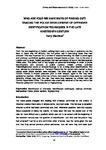Who are You? We have Ways of Finding Out! Tracing the Police Development of Offender Identification Techniques in the Late Nineteenth Century
| dc.contributor.author | Stanford, Terry | |
| dc.date.accessioned | 2017-03-14T15:54:22Z | |
| dc.date.accessioned | 2017-04-10T15:51:07Z | |
| dc.date.available | 2017-03-14T15:54:22Z | |
| dc.date.available | 2017-04-10T15:51:07Z | |
| dc.date.issued | 2009-03 | |
| dc.identifier.citation |
Stanford, T. (2009) 'Who are You? We have Ways of Finding Out! Tracing the Police Development of Offender Identification Techniques in the Late Nineteenth Century ', Crimes and Misdemeanours: Deviance and the Law in Historical Perspective, 3(1), pp.54-81. Available at: https://pearl.plymouth.ac.uk/handle/10026.1/8838 | en_US |
| dc.identifier.issn | 1754-0445 | |
| dc.identifier.uri | http://hdl.handle.net/10026.1/8838 | |
| dc.description.abstract |
From the very beginning of modern policing there were a number of problems; not the least of these was the difficulty that the police had in identifying those they had arrested. This was important for a number of reasons including the need to prove ages and previous convictions against persons charged before a court. Due to the size of London and its large, mobile population, this was particularly difficult in the Metropolitan Police area. The police had to rely largely on personal knowledge in order to prove identifications and contacts at police stations. Initially officers attended Police/Magistrates courts at remand hearings to try to bring about identifications, this was followed by attendances at Remand Prisons but the system only started to show results when prison warders were included. The other step taken was to visit the Convict Prisons to inspect prisoners prior to their release, again in this they were assisted by warders. Initially uniformed officers were used in these tasks but eventually detective officers took over the role, they were later replaced by officers from the Convict Supervision Office. The problem was eventually resolved at the very end of the Victorian period with the introduction of fingerprinting. | en_US |
| dc.language.iso | en | en_US |
| dc.publisher | University of Plymouth | |
| dc.rights | Attribution 4.0 International (CC BY 4.0) | * |
| dc.rights.uri | https://creativecommons.org/licenses/by/4.0/ | * |
| dc.subject | identification of offenders | en_US |
| dc.subject | identification techniques | en_US |
| dc.subject | habitual criminals | en_US |
| dc.subject | Metropolitan Police | en_US |
| dc.subject | prison warders | en_US |
| dc.subject | fingerprinting | en_US |
| dc.title | Who are You? We have Ways of Finding Out! Tracing the Police Development of Offender Identification Techniques in the Late Nineteenth Century | en_US |
| dc.type | Article | en_US |
| dc.type | Article | |
| plymouth.issue | 1 | |
| plymouth.volume | 3 | |
| plymouth.journal | SOLON Crimes and Misdemeanours |



